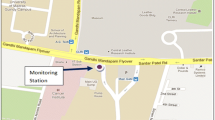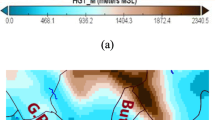Abstract
Many methods are available for air quality forecasting based on statistical and back trajectory models which require past time series data. Future air quality prediction through models is the best tool to make rational decisions by policy maker. Limited work has been done on air quality forecasting using dispersion models which require better meteorological boundary conditions. The Weather Research and Forecasting (WRF) and American Meteorological Society/Environmental Policy Agency Regulatory Model (AERMOD) models have not yet been combined for air quality forecasting. Here, a case study has been carried out to forecast air quality using onsite meteorological data from WRF model and a dispersion model named AERMOD. Prior to the use of AERMOD, a comprehensive emission inventory has been prepared for all the sources in the study region Chembur of Mumbai city. Chembur has been notified as the “air pollution control region” by local authority due to high levels of air pollution caused by the presence of four major industries, six major roads in addition to a crematorium and a biomedical waste incineration facility. The WRF–AERMOD system was applied for prediction of concentration levels of pollutants SO2, NO x and PM10. A reasonable agreement was obtained when predicted values were compared with observed data. Results of the study indicated that forecasting of air quality can be carried out using AERMOD with forecasted meteorological parameters derived from WRF without any requirement of past time series air quality data. Such kind of forecasting method can be used for air quality management of any region by policy makers.








Similar content being viewed by others
References
Alcamo J, Mayerhofer P, Guardans R, Van Harmelen T, Van Minnen J, Onigkeit J, Posch M, Vries B De (2002) An integrated assessment of regional air pollution and climate change in Europe: findings of the AIR-CLIM Project. Sci Policy 5:257–272
Astitha M, Kallos G, Katsafados P (2008) Air pollution modeling in the Mediterranean Region: analysis and forecasting of episodes. Atmos Res 89:358–364. doi:10.1016/j.atmosres.2008.03.006
Barbera E, Currò C, Valenti G (2010) A hyperbolic model for the effects of urbanization on air pollution. Appl Math Model 34:2192–2202. doi:10.1016/j.apm.2009.10.030
Bollen J, van der Zwaan B, Brink C, Eerens H (2009) Local air pollution and global climate change: a combined cost-benefit analysis. Resour Energy Econ 31:161–181. doi:10.1016/j.reseneeco.2009.03.001
Bollen J, Hers S, van der Zwaan B (2010) An integrated assessment of climate change, air pollution, and energy security policy. Energy Policy 38:4021–4030. doi:10.1016/j.enpol.2010.03.026
Brandt J, Silver JD, Christensen JH, Andersen MS, Bønløkke JH, Sigsgaard T, Geels C, Gross A, Hansen AB, Hansen KM, Hedegaard GB, Kaas E, Frohn LM (2013) Assessment of past, present and future health-cost externalities of air pollution in Europe and the contribution from international ship traffic using the EVA model system. Atmos Chem Phys 13:7747–7764. doi:10.5194/acp-13-7747-2013
CEPI (2010) Comprehensive environmental pollution index. Central Pollution Control Board Ministry of Environment and Forests, New Delhi, India
Chuang M-T, Zhang Y, Kang D (2011) Application of WRF/Chem-MADRID for real-time air quality forecasting over the Southeastern United States. Atmos Environ 45:6241–6250. doi:10.1016/j.atmosenv.2011.06.071
Cimorelli AJ, Perry SG, Venkatram A, Weil JC, Paine RJ, Wilson, Robert B, Lee RF, Peters WD, Brode RW, Paumier JO (2004) AERMOD: description of model formulation. EPA-454/R-03-004, USEPA, USA
Debry E, Mallet V (2014) Ensemble forecasting with machine learning algorithms for ozone, nitrogen dioxide and PM10 on the Prev’Air platform. Atmos Environ 91:71–84. doi:10.1016/j.atmosenv.2014.03.049
Djalalova I, Delle Monache L, Wilczak J (2015) PM2.5 analog forecast and Kalman filter post-processing for the Community Multiscale Air Quality (CMAQ) model. Atmos Environ 108:76–87. doi:10.1016/j.atmosenv.2015.02.021
Duh J-D, Shandas V, Chang H, George LA (2008) Rates of urbanisation and the resiliency of air and water quality. Sci Total Environ 400:238–256. doi:10.1016/j.scitotenv.2008.05.002
EP (2000) Introduction to fugitive emissions monitoring. Environmental programs self-instructional manual APTI course SI: 380 first edition. https://trainex.org/web_courses/subpart_x/TopicSearch%20pdf%20files/pdf%20docs%20ABC/APTICourse380.pdf
EPA (1999) Interpretation of the definition of fugitive emissions in parts 70 and 71. Air Protection Division, Region III (3AT00). http://www.epa.gov/region07/air/title5/t5memos/fug-def.pdf
Fridell E, Haeger-Eugensson M, Moldanova J, Forsberg B, Sjöberg K (2014) A modelling study of the impact on air quality and health due to the emissions from E85 and petrol fuelled cars in Sweden. Atmos Environ 82:1–8. doi:10.1016/j.atmosenv.2013.10.002
Grell G, Baklanov A (2011) Integrated modeling for forecasting weather and air quality: a call for fully coupled approaches. Atmos Environ 45:6845–6851. doi:10.1016/j.atmosenv.2011.01.017
Gulia S, Shrivastava A, Nema AK, Khare M (2015) Assessment of urban air quality around a heritage site using AERMOD: A case study of Amritsar City, India. Environ Model Assess. doi:10.1007/s10666-015-9446-6
Henmi T, Flanigan R, Padilla R (2005) Development and application of an evaluation method for the WRF mesoscale model. Army Research Laboratory, ARL-TR-3657
Kan H, Huang W, Chen B, Zhao N (2009) Impact of outdoor air pollution on cardiovascular health in Mainland China. CVD Prev. Control 4:71–78. doi:10.1016/j.cvdpc.2008.08.004
Kan H, Chen R, Tong S (2012) Ambient air pollution, climate change, and population health in China. Environ Int 42:10–19. doi:10.1016/j.envint.2011.03.003
Kanada M, Fujita T, Fujii M, Ohnishi S (2013) The long-term impacts of air pollution control policy: historical links between municipal actions and industrial energy efficiency in Kawasaki City, Japan. J Clean Prod 58:92–101. doi:10.1016/j.jclepro.2013.04.015
Kesarkar AP, Dalvi M, Kaginalkar A, Ojha A (2007) Coupling of the weather research forecasting model with AERMOD for pollutant dispersion modelling. A case study for PM10 dispersion over the Pune city. Atmos Environ 41:1976–1988
Kumar A, Goyal P (2011) Forecasting of daily air quality index in Delhi. Sci Total Environ 409:5517–5523. doi:10.1016/j.scitotenv.2011.08.069
Kumar A, Dixit S, Varadarajan C, Vijayan A, Masuraha A (2007) Evaluation of the AERMOD dispersion model as a function of atmospheric stability for an urban area. Environ Prog 25:141–151. doi:10.1002/ep.10129
Kumar P, Kishtawal CM, Pal PK (2014) Impact of satellite rainfall assimilation on Weather Research and Forecasting model predictions over the Indian region. J Geophys Res Atmos 119(5):2017–2031
Kumar P, Kishtawal CM, Pal PK (2015a) Skill of regional and global model forecast over Indian region. Theor Appl Clim 123(3):629–636
Kumar A, Dikshit AK, Fatima S, Patil RS (2015b) Application of WRF model for vehicular pollution modelling using AERMOD. Atmos Clim Sci 5:57–62
Kumar A, Gupta I, Brandt J, Kumar R, Kumar A, Patil RS (2016a) Air quality mapping using GIS and economic evaluation of health impact for Mumbai city, India. J Air Waste Manag Assoc 66:470–481
Kumar A, Patil RS, Dikshit AK, Islam S, Kumar R (2016b) Evaluation of control strategies for industrial air pollution sources using American Meteorological Society/Environmental Protection Agency Regulatory Model with simulated meteorology by Weather Research and Forecasting Model. J Clean Prod 116:110–117. doi:10.1016/j.jclepro.2015.12.079
Kumar A, Patil RS, Dikshit AK, Kumar R (2016c) Comparison of predicted vehicular pollution concentration with air quality standards for different time periods. Clean Technol Environ Policy. doi:10.1007/s10098-016-1147-6
Kumar A, Patil RS, Dikshit AK, Kumar R (2016d) Air quality assessment using interpolation technique. Environ Asia 9:140–149. doi:10.14456/ea.2010.32
Ma J, Yi H, Tang X, Zhang Y, Xiang Y, Pu L (2013) Application of AERMOD on near future air quality simulation under the latest national emission control policy of China: a case study on an industrial city. J Environ Sci 25:1608–1617. doi:10.1016/S1001-0742(12)60245-9
Mohan M, Bhari S, Sreenivas A, Marrapu P (2011) Performance evaluation of AERMOD and ADMS-urban for total suspended particulate matter concentrations in megacity Delhi. Aerosol Air Qual Res 11:883–894. doi:10.4209/aaqr.2011.05.0065
Mokhtar MM, Hassim MH, Taib RM (2014) Health risk assessment of emissions from a coal-fired power plant using AERMOD modelling. Process Saf Environ Prot 92(5):476–485
NCAR (2011) Advanced research WRF user’s guide, Mesoscale and Microscale Meteorology Division, National Center for Atmospheric Research, Boulder, Colorado, USA
NEERI (2010) Air quality assessment, emission inventory and source apportionment studies: Mumbai National Environmental Engineering Research Institute CPCB, New Delhi
O’Shaughnessy PT, Altmaier R (2011) Use of AERMOD to determine a hydrogen sulfide emission factor for swine operations by inverse modeling. Atmos Environ 45:4617–4625. doi:10.1016/j.atmosenv.2011.05.061
Patankar AM, Trivedi PL (2011) Monetary burden of health impacts of air pollution in Mumbai, India: implications for public health policy. Public Health 125:157–164. doi:10.1016/j.puhe.2010.11.009
Poupkou A, Markakis K, Liora N, Giannaros TM, Zanis P, Im U, Daskalakis N, Myriokefalitakis S, Kaiser JW, Melas D, Kanakidou M, Karacostas T, Zerefos C (2014) A modeling study of the impact of the 2007 Greek forest fires on the gaseous pollutant levels in the Eastern Mediterranean. Atmos Res 149:1–17
Rao S, Pachauri S, Dentener F, Kinney P, Klimont Z, Riahi K, Schoepp W (2013) Better air for better health: forging synergies in policies for energy access, climate change and air pollution. Glob Environ Change 23:1122–1130. doi:10.1016/j.gloenvcha.2013.05.003
Ray S, Kim K-H (2014) The pollution status of sulfur dioxide in major urban areas of Korea between 1989 and 2010. Atmos Res 147–148:101–110. doi:10.1016/j.atmosres.2014.05.011
Seaman NL (2000) Meteorological modeling for air-quality assessments. Atmos Environ 34:2231–2259
Seangkiatiyuth K, Surapipith V, Tantrakarnapa K, Lothongkum AW (2011) Application of the AERMOD modeling system for environmental impact assessment of NO2 emissions from a cement complex. J Environ Sci 23:931–940. doi:10.1016/S1001-0742(10)60499-8
Sellier Y, Galineau J, Hulin A, Caini F, Marquis N, Navel V, Bottagisi S, Giorgis-Allemand L, Jacquier C, Slama R, Lepeule J (2014) Health effects of ambient air pollution: do different methods for estimating exposure lead to different results? Environ Int 66:165–173. doi:10.1016/j.envint.2014.02.001
Sirajuddin M, Ravichandran M (2010) Ambient air quality in an Urban area and its effects on plants and human beings: a case study of Tiruchirappalli, India. Kathmandu Univ J Sci Eng Technol 6:13–19
Sistla G, Zhou N, Hao W, Ku J-Y, Rao ST, Bornstein R, Freedman F, Thunis P (1996) Effects of uncertainties in meteorological inputs on urban airshed model predictions and ozone control strategies. Atmos Environ 30(12):2011–2025
Song W, Liu M (2014) Assessment of decoupling between rural settlement area and rural population in China. Land Use Policy 39:331–341. doi:10.1016/j.landusepol.2014.02.002
Swerts E, Pumain D, Denis E (2014) The future of India’s urbanization. Futures 56:43–52. doi:10.1016/j.futures.2013.10.008
Tartakovsky D, Broday DM, Stern E (2013) Evaluation of AERMOD and CALPUFF for predicting ambient concentrations of total suspended particulate matter (TSP) emissions from a quarry in complex terrain. Environ Pollut 179:138–145
URL1: 43 industrial clusters imperiled in India. http://www.dnaindia.com/india/report-43-industrial-clusters-imperiled-in-india-1327305. Accessed 20 Jan 2016
URL2: Mumbai gets most polluted in Dec: environment report, Hindustantimes. http://www.hindustantimes.com/india-news/mumbai. Accessed 20 Jan 2016
Van Vliet O, Krey V, McCollum D, Pachauri S, Nagai Y, Rao S, Riahi K (2012) Synergies in the Asian energy system: climate change, energy security, energy access and air pollution. Energy Econ 34:S470–S480. doi:10.1016/j.eneco.2012.02.001
Vieira de Melo AM, Santos JM, Mavroidis I, Reis Junior NC (2012) Modelling of odour dispersion around a pig farm building complex using AERMOD and CALPUFF. Comparison with wind tunnel results. Build Environ 56:8–20. doi:10.1016/j.buildenv.2012.02.017
Voukantsis D, Karatzas K, Kukkonen J, Räsänen T, Karppinen A, Kolehmainen M (2011) Intercomparison of air quality data using principal component analysis, and forecasting of PM10 and PM2.5 concentrations using artificial neural networks, in Thessaloniki and Helsinki. Sci Total Environ 409:1266–1276. doi:10.1016/j.scitotenv.2010.12.039
Westerlund J, Urbain J-P, Bonilla J (2014) Application of air quality combination forecasting to Bogota. Atmos Environ 89:22–28. doi:10.1016/j.atmosenv.2014.02.015
Yahya K, Zhang Y, Vukovich JM (2014) Real-time air quality forecasting over the southeastern United States using WRF/Chem-MADRID: multiple-year assessment and sensitivity studies. Atmos Environ 92:318–338. doi:10.1016/j.atmosenv.2014.04.024
Zou B, Benjamin Zhan F, Gaines Wilson J, Zeng Y (2010) Performance of AERMOD at different time scales. Simul Model Pract Theory 18:612–623. doi:10.1016/j.simpat.2010.01.005
Acknowledgements
We thank the Centre for Development of Advanced Computing (C-DAC) for providing the PARAM YUVA Super Computing facility to process the code of WRF model.
Author information
Authors and Affiliations
Corresponding author
Rights and permissions
About this article
Cite this article
Kumar, A., Patil, R.S., Dikshit, A.K. et al. Application of AERMOD for short-term air quality prediction with forecasted meteorology using WRF model. Clean Techn Environ Policy 19, 1955–1965 (2017). https://doi.org/10.1007/s10098-017-1379-0
Received:
Accepted:
Published:
Issue Date:
DOI: https://doi.org/10.1007/s10098-017-1379-0




